
In the Wings of

The Dutch Cleopatra
(Fred van Doorn in Haagse Post)
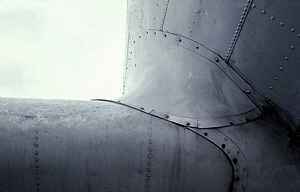
| Pre-Production |
| What Wim originally had in mind was a movie in the honored tradition of fast-action adventure films. His original idea, worked into a screenplay by Charles Gormley, moved along those lines. This was supposed to be photographed on the 16mm format (for blow-up to 35mm) by Mat van Hensbergen, who had been the cinematographer for many early Pim & Wim productions, to note Liefdesbekentenissen. Wim was talked out of that; it became Techniscope with Jan de Bont, who had also shot Blue Movie, doing camera. Wim, like me, has been an airplane freak all his life. As I read the original script, it already was more about the legendary DC-3 aircraft than about the more-or-less standard plot turns involving a junkie and a chick, cops and robbers. Those merely provided an excuse to show off that Magnificent Flying Machine; not only as the real heroine of the story, but doing triple service as a set and as a transport unit for cast and crew. The PH-MAG DC-3, till then in service with Moorman Air at Schiphol, was bought and re-conditioned. This cost a fortune. As a PR-stunt, $corpio took a bunch of journalists and/or their partners to the Cannes Film Festival in it. Upon take-off after a fuel stop at a French airport, one of the magnetos started acting up and had to be replaced. When the husband of one of those aboard heard this, he resolutely forbid her to continue this dangerous adventure; she had to take the train for the rest of the journey. the Cast Kees Brusse, one of the greater names in Dutch movie actors (also in Blue Movie and VD) would play the flyer/owner of the Dakota. His name in the movie is Dick de Boer, that of the co-pilot because that guy's leather bag was gold-stamped with the name and could be used as a prop. Monique van de Ven was contracted for the female lead. She had been discoveredby Rob Houwer for his Turks Fruit production by director Paul Verhoeven. A typical mindless chick of the type the inner city scene of the Hague was chock-full with, but that must have been refreshing to the provincial Amsterdammers, who you can only get to leave their town for a visit to a foreign country or to go to the beach in Zandvoort, and maybe to the tv-studios in Hilversum. Rudolf Lucieer, the actor in Wim's first feature Joszef Katus [and a lot more words] and VD was supposed to play a junkie. |
all stars: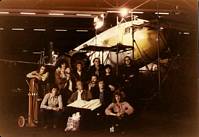 Kees, Dakota and crew |
|
the Crew Mainly the same bunch we'd all gotten used to working with on the set in preceding productions. Ulli make-up, Kees sound, Wim of course, Frans and Pim production, Jan, Werner and Marc camera, Cor light, myself stills, Olga assistant director. In Curaçao Ben Willems was added to the production department. The flight crew consisted of captain Sander (who was disappointed, as these people who made Blue Movie were not anywhere near as much into orgies as he'd expected;) co-pilot Dick (who had logged a total of more hours than Sander, but less on the DC-3;) and mechanic Ome Ben [Unca Ben], by which name he turned out to be known at every airport where we touched down. Ome Ben really earned his keep. A firm follower of Murphy, he had a healthy mistrust of all things that could go wrong. He always listened in to the pilot's conversations with the tower, standing with earphones clamped on in the cockpit door, Phillips screwdriver in his back trouser pocket. Observing the DC-3 from the ground, he once observed:Wim ter Hart flew chase plane.Look at that, it has a light on top and a light on the bottom and at times when you still can't see any of them.He for sure didn't go along up when we filmed the stall (which was not in the movie either); I was the only one except the two pilots who joined that ride. (The DC-3 just started a smoooth glide down, perfectly balanced after all those years of rough service.) Altogether, a crew of sixteen of which ten on the set — very small for this type of movie, but all of us were quite used to that. Wim first flew to Curaçao for his first visit in twenty years; a few weeks before production started, I flew over there myself. On Wim's request, I wrote him a forty page letter with advises on color styling, camera movements, locations and that sort of stuff; somewhat like what Saul Bass might be expected to throw out (but just maybe not quite so good). This is why one 'Johnny Rankin' appears in the credits as a member of a stampeding mob of screenplay writers, among whom myself again under my own name! Using that assumed name was intended to prevent trouble with champ ego-tripper Jan before we even started shooting. We need not have bothered. The name chosen was that of a color-blind WWII spy who has been sitting on a Lisboa terrace for a week with a glass of orange juice as a sign to a contact; only, it was supposed to be lemon squash so he was out of luck. That's how Wim told the story; a good enough pseudonym for a color stylist, right?A couple of months later Pim and Frans came production-preparing as well, not both at the same time. As I was there already, I met those two. Pim insisted on visiting the infamous Campo Alegre bordello with me, but no business resulted. Frans, with whom we just went for swims and other innocent pastimes, got an eye infection, which handicapped his work. Wim claimed he'd got that way because he had gone by the whores, but I wouldn't know. You have to know that Wim could be, and often was, terribly strong headed and obstinate. He stuck to his opinions, which naturally were not always right; it happens to all of us. One example is that he kept telling me that Daan van der Vat, with Jan de Hartog one of the two Dutch authors I still find worth my while, had been fout,wrongi.e. a collaborator with the Germans, in World War II. I always asked him where I could check this out, but he just knew. Not so, as I found out: Not only was this totally incompatible with the guy's healthy anti-autocratic mentality — he actually was already living in London long before the war broke out. |
| in the cockpit Kees Brusse & Wim Verstappen 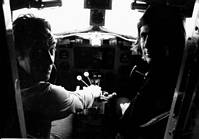 |
Get this straight right now: The varmint in this story is Jan de Bont. I do not think he is any good as a cinematographer, but even worse, he as a person is a real schmuck. Vain and conceited. From the first time I met him, he reminded me of the stereotype photographer, better and more lovingly described than I could hope to put it myself, like this:
Photographers are monkeys. I mean, they're really monkeys. You know, most photographers are very short and have very long arms. I guess the long arms come from carrying those bags around—that's a lot of equipment they haul around. Some photographers' arms scrape the ground, they're so long.That's Jan to a T. Now, in another production before Dakota he'd started fooling around with Marc's partner, about which affair Kees told me disgustedly they were behaving absolutely like children. Marc was very cool working under these conditions, but of course it meant Strouble and Tress. |
| On Location |
Once the DC-3 had made its way across the ocean, the rest of the crew flew over in a KLM DC-8. Full of Curaçao passengers, and Curaçao at the time was very puritanical, you'd better believe it. So Jan and Monique starting necking and petting aboard, scandalizing the other passengers by taking her tits out en plein public. Absolutely like children. Two other stories that deserve to be told. One is that Jan was, presumably still is, sterile, and for years had used that argument to persuade chicks to have a risk-free tumble in the sack with him (no HIV around yet). All Amsterdam may have known about this, but the Hague Monique didn't. For years later she kept the relationship going, hoping for a child; but it somehow slipped Jan's mind to tell her. I don't know if it's true, just give you what I heard.So there we were in Curaçao, shooting on Hato Airport where heat waves shimmered over the concrete runway, the Trade Wind blowing away what rested of our bodily fluids. The station wagon Kees Brusse drives in the movie did double duty as a catering vehicle, with the back door turned down. Every free moment Jan and Monique were at liberty, they settled down on that back door to start necking, showing everybody how terribly in love they were. Problem was, they effectively shut off the cooling box for the rest of the crew, who, when they yearned for refreshment, had to disturb the Great Lovers Through the Ages to get 'em out of the way. But that was only a small inconvenience, comparing. Jan just did a very bad job. Later, it turned out he was under enormous stress and really shouldn't have accepted this gig, but follow a rest cure instead. As he had refused to shoot VD before and had no problem then referring Wim to another cameraman, one is entitled to jump to the conclusion that here it must have been Monique's attractions that proved fatal. To Wim, at least. |
 Animation by Preston Blair    |
Jan tried everything to get Monique in the picture at what he, at least, must have figured was her best advantage. He coached her to walk and stand like what in cartoons is called the cutefigure, mainly characterized by a bulging tummy. As if that wasn't bad enough, he always tried to photograph a scene so that she appeared at her most advantageous, no matter what was important for the movie. I remember once, working in Willemstad in front of the West-End theater, that he tried to choreograph a street scene, involving a following car, so as to show her off better, with the end result that you hardly noticed her at all anymore. (This scene is not in the movie.) That's how clever a cameraman he was; Kees and I looked at each other and literally burst out laughing. We needed footage of the Dakota flying, of course. After Wim had made two trips with Jan in the chase plane for that purpose, he got so disgusted he didn't want any anymore, and asked me to go along instead. The reason became obvious soon enough: At the moment the wheels left the ground, Jan's finger hit the camera start button, only to release it to stretch out his hand for a fresh magazine. Eastmancolor Negative costs money, you know. Upon our return to Holland, we all spent two days in the Cinetone projection room, watching rushes practically showing nothing but a flying DC3 and the Curaçao coast line. It didn't stop there. Apart from those cables we received from Technicolor London suggest definitely NG, Jan just refused to shoot according to the instructions Wim gave him. Well, one specific problem then with Dutch movies was (there were and are many more:) camera persons were much more experienced than directors, and they just judged they knew better. Very difficult, as they were right in many cases; but come right down to it, you have to do what the director instructs you to do. Result was, with many delays caused by misunderstandings, infights and quibbling, that many Curaçao scenes we were supposed to get in the can were never shot. Not a single shot was made with Rudolf Lucieer all the time we, and he, were there. Apart from the obvious waste of money, this is not something an actor can allow himself to take lightly. At a certain point, Wim instructed me to go out with Olga and Werner on 2nd unit location shooting. I've been told that he, for once, that night arrived in his hotel bungalow contentedly, rubbing his hands while saying Now at least we'll get some decent footage! |
 |
| Adventures in the Suriname Jungle |
Though we did make a trip to the windward island of St. Maarten and to Aruba, we never got around to the planned shots in Colombia, for which we'd had been inoculated against all kinds of nasty diseases. The flight to Suriname, from where in the movie the DC-3 starts its journey to Europe, I made in the chase plane. However, next day I was in the Dakota when we flew on to our location, a bush strip in the interior of that country.
I have to tell you this. Another piece of bad luck we had was that Kees Brusse at that time was afraid of flying. (He took flying lessons since then and even got his license.) After the DC-3 made a perfect landing on that strip, Kees was the first one to jump out, and then started fulminating against the pilots for getting us all into danger with their reckless stunts. He was disappointed to the point of amazement when we did not, as he had expected, wholeheartedly agree with him. We had noticed nothing particularly dangerous.In Suriname things got so bad that Kees Linthorst and I had a grumbling conversation reviewing all this. Kees exclaimed He's making the light kaput!(we have the easiest light in the world) but Jan started using fill-in screens and that sort of thing, ruining its character. Besides, they tend to be a disaster for the sound man, and Kees had problems enough already. What with the DC-9's APUs (auxiliary power units) whistling way all day long on Hato; with the eternal Trade Wind and the puppynot even invented yet for fifteen more years; and with the 25 FPS Arriflex camera-motor, a speed meant for PAL tv transmissions and of no use whatsoever for theatrical movies. We got ourselves so worked-up that Kees started inciting me to try and convince Wim to let me take over Jan's job, even if he and I were fully well aware I hadn't ever done any cinematography before. He succeeded. So I pencil-scribbled Wim a note saying like (it wasn't any longer:) 'Things can't go on like this. Why don't you kick Jan out and have me shoot the rest?' Half an hour later, he knocked on my door, as always the crummiest room of all crew members. His text was: 'Yeah, well, I'm not crazy myself. But we just have to continue like this.' I still don't see why. Obstinate. You don't have to tell me: Of course it has occurred to me that Wim didn't trust me to do a better job than even Jan was doing. But to me, it's just a slight exaggeration to say that even a blind man would have done better. And I'm not what you'd call 'blind'. |
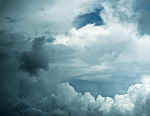 |
The whole ugly mess erupted on the last Curaçao shooting day. The Dakota was over Klein Curaçao, Werner and me in the chase plane, Kees throwing boxes out of the DC-3 cabin doors, Wim, Jan and rest of crew on that very small island. There exists a maneuver called a one-minute turn, which Wim wanted to show. At a certain point, Jan just plumb refused to shoot a certain set-up, which is unacceptable to the point of being unforgivable. So, on the way back to Curaçao by boat (which made Wim very seasick) he gave Jan his notice of dismissal. He had it all ready and typed out in his pocket. Why, then, did he wait until it definitely was too late? But the most amazing thing about all this is that, as they later told me, hardly any of the crew members had an inkling of what was going on here. I thought nobody could possibly have remained unaware of it, especially in such a small crew. |
| Interlude |
| People are curious about this as well; they don't see how you can cross the ocean at all in a DC-3. Obviously, you can, even not carrying extra drums of gasoline. We went from Curaçao to Port-au-Prince (Haïti) to Miami, day 1. Miami - Wilmington NC - Montreal (Canada), day 2. Repairs in Montreal, day 3. Montreal - Goose Bay (Labrador), day 4. Stop-over in Goose Bay, I don't remember why, day 5. Goose Bay - Bluie West One (Greenland) - Keflavik (Iceland), day 6. Repairs Iceland, day 7. Kefflavik - Prestwick (Scotland) - Amsterdam, day 8. This is not as much of a detour as you might think; from Montreal to Schiphol it's not so much different from the Great Circle route. |
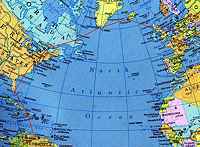 Rand McNeilly Universal World Atlas |
Footnotes: The customs people in Miami started bragging about how they took confiscated Havana cigars home; these days it probably is Colombian coke. In Montreal you never saw non-whites. No females in bars; just single guys, each at his own table, stolidly drinking. Goose Bay (where we arrived after a flight over desolate Labrador, surely bringing back memories of Ernest K. Gann and Hammond Innes) sported a menu with caribou steak which naturally I ordered, now or never, right? Never - they didn't have it. The more important buildings in that Eskimo village were interconnected with tunnels for use in winter (under the layer of snow). Every house had a snow bike like we have cars. In Bluie West One we all got a little card to prove that we'd been in the Arctic. As Greenland hadn't been properly mapped at the time and nobody really knew how high the mountains were, we had to cross it at oxygen-bottle height. We sat there with that bottle between the four of us (Olga, Wim, Marc, me), taking the occasional sip like it was a hookah. I don't know what's the usual Saturday night scene in Iceland's Reykyavik, but the city was full of puking drunks. May have been a special celebration. At Schiphol, we were almost welcomed like the crew of the Uiver or something. We weren't actually carried away on the mob's shoulders, but it came close enough. Really ridiculous; after all, at that time it was a mere twenty years ago that DC-3s crossing the ocean were just routine. |
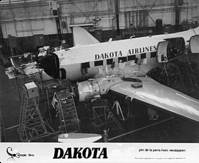 Beeg Trouble |
No doubt it was for a large part Jan de Bont influencing Monique when she went to a doctor to get a note she was over stressedand couldn't possibly continue her work as an actress. This made Kees Brusse very angry, because, as he said What BS is this? When you're acting, you're always on the verge of a nervous breakdown!It was painfully obvious that this was just a way cooked up to sabotage the production in revenge for injuring Jan's precious ego. Actually, I still see it as a crime with two accomplices, not counting the M.D. This left Wim stuck with a million-guilder movie of which much more than half the budget had been spent with hardly anything showing for it. And with a broken friendship with Rudolf Lucieer, which took many years to mend. The production was put on hold for a while, during which we looked at those rushes. I developed my negatives. The DC-3 was just sitting at Schiphol airport. Wim, Jan Verstappen, and I came together to brainstorm on what to do with the script, using as much as possible of the material that was usable while leaving no loose ends. As I remember it, we were sitting around a table at Jan's place, me mainly throwing out suggestions, Wim considering them, finally Jan doing all the hard work of typing it out and writing dialogues. After something workable had emerged, production was resumed. Monique was replaced with Willeke van Ammelrooij, then the top female star in Holland, just to show her. For those scenes where she had to be in the picture, we had a double. Her voice was dubbed by our (then) sister-in-law Etha Coster; she did a fine job indeed. She nor the stand-in got any credit, something Etha was pretty mad about; it's my guess again that this was omitted just to show Monique where it was at. Werner went back to Germany. Jan was replaced with Theo van de Sande (now, like Jan, a Hollywood resident); it may have been Theo's first feature. Cor went back to Cinetone and was replaced by Fred Petri, whose first act was to put a grounding clamp on the DC-3. Really. Followed long and dreary days of shooting in the Martinair hangar. |
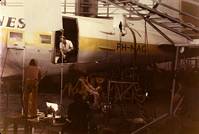 Fooling the customers: Kees Brusse throwing boxes out of a flyingDakota Frans catching |
This is where we had to move out them damn drums, needed for the ocean-crossing scenes, every so often, to replace them with the seats for other scenes; and vice-versa. It resulted in the not popular but often-repeated shout, one of those that stick in your memory when thinking back to a production:Drums d'ruit! Stoelen d'rin! [Out with the drums! In with the seats!]. The quote came back later after Het Verboden Bacchanaal, when Marc lost his girl friend once again:Out with Marc! In with Jos!To spice it up and keep my attention focussed, I devised some special effects to keep up the suggestion of an airplane actually moving through the air: Drums vibrating ever-so-slightly; a door swinging shut and open while Kees stood there shaving. Most of these you wouldn't ever notice, but those often are the best. |
We then moved our collective asses to the Amsterdam Cinetone studios, where a set reproduced the Willemstad boarding room of the pilot character - after transparencies Frans Rasker and I had, in a rare attack of wise farsightedness, decided to make from the original when trouble was hardly a-brewing yet. As a matter of fact, that was the house Willy and I had rented a room in before we had to move to that stupid hotel. Now burned down, it was opposite the Willemstad floating market, on the harbor quay, next to where now the Maritime Museum is. Followed a couple of days of location shooting and finally, some days of shooting with the DC-3 on the North Sea Ameland island. That wrapped it up. The longest production I ever worked on, except for my own Edgar Palm en Otrabanda. That one's still in the making after over twenty years. |
Aftermath |
After the distributor had seen the first Technicolor print, he was the first one to arrive at the conclusion that he had the best set of stills for any $corpio production ever. That was the first good thing I'd heard about them. Pim told me about this, adding hastily: But that was at two o'clock in the morning. It was an awful flop. Not in the least, I feel, because of the poster which suggested you'd get to see some boys' book type of adventure. This may have fitted in with the original screenplay, but the film as it finally turned out was a completely different trip altogether. Wim hated that poster, and I omitted to tell Frans about this until after the same outfit had designed one for Mens-Erger-Je-Niet! I have no idea why Wim hadn't told him long before; but Wim did have that habit of shutting up about things like that. Wim made a habit of blaming things that didn't go as he wanted them to on other people. He once told me that Oswald Morris had offered him to shoot a movie for him, which he never took up. I would have jumped at it, not even considering that he was actually cheaper than his Dutch counterparts. Wim hardly ever looked through a viewfinder, not so much because his idol Hitchcock never did so as because, like he once told me, what he saw there was so different from what he'd imagined that he preferred not to deal with it. Mulish. I am not the first one to have remarked that his movies look much better in script than finished, and that my stills suckered the audience into expecting a better film than they actually got to see. I have this private theory that this may go a long way to explain why he didn't agree to me taking over, in Suriname, from Jan. Could well be my ego tripping away, I cordially concede. |
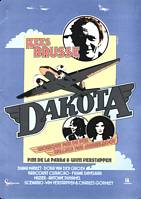 |
Still later, Wim sat behind his desk in the $corpio office and, out of the blue, came out with the remark I wish I had Monique here to grab her head between my hands and beat it on a kerbstone.. About then, he concluded that what the film had really needed from the very start was an actress like Shelley Winters. Right, and she would have done it too, for an affordable fee - she was into that sort of thing, just for kicks. Another remark of his was that he knew exactly who, at what point in the production, had left him in the lurch. The Rolex watch Then, maybe still, the standard best watch as worn by flyers. We somehow had organized one from the factory. (It was this watch that was essential to show the '1 minute turn' maneuver over Klein Curaçao which got Jan fired.) As it turned out, it was on loan and might they kindly have it back. Cheapskates. So Wim wrote them back, alas, they had given it to the star. (He wore it himself.) Years later Wim sent me this letter that Monique was back in Holland and had a new friend: 'Oh, she was soooo happy!' Followed an angry one: He had met her at some occasion where Frans force him to shake hands with her, so now the quarrel was over officially and they were good little friends. He was absolutely disgusted. He didn't agree with it, and it didn't agree with him. |
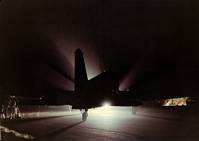 Later, when I gave Wim this picture, his come-back was: This should have been in the movie. Is what I felt. But he never arrived at the logical conclusion. Jan de Bont went on to Hollywood to try and become a Big Shot, and in a way succeeded. He produced or directed some terrible flops that lost much more money than Dakota, but that doesn't seem to matter so much in Hollywood. Don't ask me to explain. He acquired an alias (Jon de Bant) because his name was pronounced wrongly. Jan de Hartog never bothered, of course. But that Jan was a great man! Later on, he again seems to've changed his name, this time to Jan Debont, and actually made a (surprise!) hit, Speed. |
R.I.P. |
| After Wim had died in 2004, the Nederlands Filmmuseum produced a digitally restored print which was released in 2005. It was a greater success than at its original release (that's not saying much, yeah.) I, for one, will maintain until my own dying day that it's by far the best film Wim ever made. If not the only really good one. But I haven't seen all of them. |
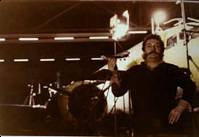
Ulli Ullrich
and main billing star model
There are plenty more good stories that could be told.
'Nuff is sufficient, already.
Okay, so just one that may amuse you. Occurred to me many years later:
Vertigo, not—Fear of Heights, Yes
We were flying in the Dakota somewhere over the Caribbean Sea, for some reason with the cabin door open. I, for some other reason, with my fear of heights, regardless sitting in the door opening with feet dangling in the empty space (no safety belt or nothing) when assistent direcrtor Olga Madsen discovered me there and started yelling at me to come inside NOW!.
Upon reflection, I could only concede she had a good point, so I did follow her advice.
Why didn't I get acute acrophobia in the first place? So don't ask! I've hit upon one explanation, saying that when there's no visual contact with the solid ground, you don't get it. Maybe. I really don't know.
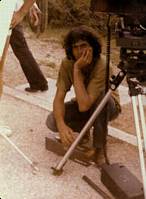
photo by star builder
Ulli Ullrich
When you love flyers and flying, you ought to read
Ernie Gann
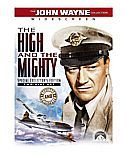   William Wellman 1954, 1st VistaVision film |
    Laszlo Pal video |
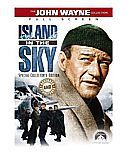   William Wellman 1953 |
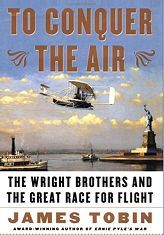    |
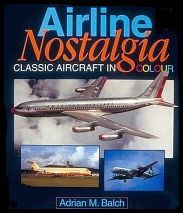    |
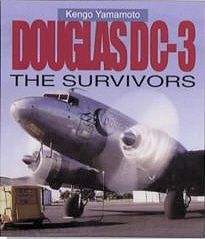    |
SEARCH this site or the Web

all material on this site, except where noted
copyright © by harrie verstappen , curaçao
reproduction in any form for any purpose is prohibited
without prior consent in writing